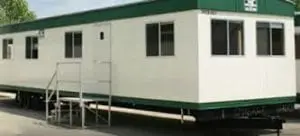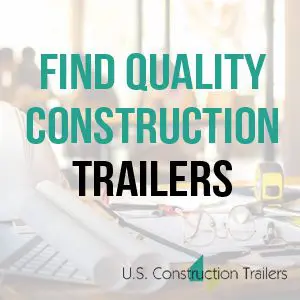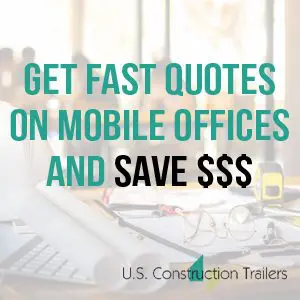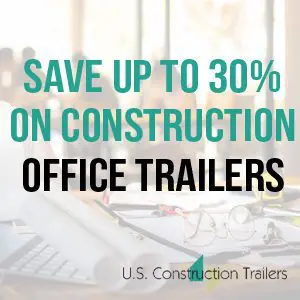
A Step-by-Step Guide to Buying Used Jobsite Trailers
When it comes to equipping your worksite with the necessary amenities, a jobsite trailer can be a game-changer. Used jobsite trailers, in particular, offer a cost-effective and flexible solution. However, navigating the process of selecting and setting up a used jobsite trailer can be daunting. This comprehensive guide is designed to walk you through each step, ensuring that you make an informed decision that best suits your needs.
Understanding Your Jobsite Trailer Requirements
Embarking on the journey of selecting the right used jobsite trailer begins with a clear understanding of your specific requirements. This step is crucial because it lays the foundation for making an informed decision that aligns perfectly with the needs of your project and crew. Let’s delve deeper into how you can assess and articulate these needs effectively.
Evaluating the Scope and Scale of Your Project
Project Duration and Size
- The duration and scale of your project play a significant role in determining the type and size of the trailer you need. For long-term projects, you may require a larger, more durable trailer, whereas a smaller one might suffice for shorter assignments.
Crew Size and Space Requirements
- Consider the number of people who will be using the trailer. Will it be used as a break room, an office, or both? The answer will dictate not only the size but also the layout and facilities within the trailer.
Identifying Specific Functional Needs
Office Space
- If the trailer is to be used as a mobile office, consider the need for desks, chairs, and areas for meetings or private discussions. This requirement will influence the interior layout and the need for electrical and internet connectivity.
Storage Capabilities
- For storing tools, equipment, or materials, you’ll need a trailer with adequate storage space. Shelving, security features, and ease of access are important factors to consider.
Specialized Facilities
- Some projects may require trailers with specialized facilities, such as drafting tables, planning areas, or technology stations.

Understanding Site Limitations and Opportunities
Physical Space Constraints
- The physical space where you plan to place the trailer can limit your choices. Make sure to measure the area and consider any potential obstacles for delivery and setup.
Accessibility and Transportation
- Consider how the trailer will be transported to and from the site. Ensure that the site is accessible for delivery vehicles and that there is enough space for safely placing and installing the trailer.
Legal Compliance and Permitting
Zoning Laws and Regulations
- Be aware of local zoning laws and building codes that may affect the placement and use of your trailer. Some areas might have restrictions on the size or type of trailer you can use.
Permit Requirements
- Depending on your location, you may need permits for a jobsite trailer. This process can take time, so it’s important to start early to avoid delays.
Budget and Cost Implications
Upfront Costs vs. Long-Term Value
- While sticking to your budget is important, consider the long-term value of the trailer. A slightly higher upfront cost for a trailer that better suits your needs can be a more economical choice in the long run.
Operational Costs
- Factor in the costs of running the trailer, including utilities, maintenance, and any necessary modifications or repairs.
Understanding your jobsite trailer requirements is about more than just picking a model. It’s about thoroughly assessing your project’s needs, the crew’s comfort, site constraints, legalities, and budget.

Getting Started: Choosing the Right Used Jobsite Trailer
Selecting the right used jobsite trailer is a critical decision that can impact the efficiency and success of your project. With a variety of options available in the market, it’s important to make an informed choice that aligns with your specific needs. Here’s a detailed look at the essential considerations to help you choose the right jobsite trailer for your needs.
Types of Jobsite Trailers
Office Trailers
- Designed for administrative work, they often come equipped with desks, filing cabinets, and electrical hookups.
- Ideal for project managers, architects, and engineers who need a workspace on site.
Storage Trailers
- These are primarily used for securely storing tools, equipment, and materials.
- Essential for sites where secure, weatherproof storage is a priority.
Combination Trailers
- Offer both office space and storage capabilities.
- Suitable for smaller sites where space is limited, and dual functionality is required.
Size and Layout
Assessing Size Requirements
- Consider the number of people who will use the trailer and the intended use. A larger crew or dual-purpose use (office and storage) typically requires a larger trailer.
- Ensure the trailer size is compatible with the available space at your site.
Layout Efficiency
- The internal layout should cater to your operational flow. For instance, if the trailer is used as an office, is there enough space for meetings? If it’s for storage, are items easily accessible?
Condition and Quality
Structural Integrity
- Inspect the trailer for any signs of structural damage like rust, dents, or warping. The condition of the frame and chassis is particularly important for the longevity of the trailer.
Interior Check
- Look for signs of leaks or water damage. Check the condition of floors, walls, and ceilings.
- Ensure that doors and windows operate smoothly and provide adequate security.
Features and Amenities
Power and Connectivity
- For office use, check the electrical system, outlets, and internet connectivity options.
- Consider the need for heating, air conditioning, and lighting based on climate and working hours.
Customization Potential
- Consider how easily the trailer can be customized to meet your specific needs. Can it be modified or upgraded without significant expense?

Transportation and Setup
Delivery and Installation
- Understand the logistics of transporting and installing the trailer. Ensure the seller offers delivery and can maneuver the trailer into your desired location.
- Plan for the setup process, including leveling the trailer and connecting utilities.
Regulatory Compliance
Building Codes and Permits
- Ensure the trailer meets local building codes and safety regulations.
- Check if permits are required for installation and how long the approval process takes.
Budget Considerations
Cost vs. Value
- While price is an important factor, consider the overall value the trailer offers in terms of longevity, functionality, and adaptability to various needs.
- Account for potential refurbishment costs that may be needed to tailor the trailer to your specific requirements.
Choosing the right used jobsite trailer involves a careful assessment of your project needs, thorough inspection of the trailer’s condition, understanding of the necessary features and amenities, and consideration of logistics and legal compliance. By taking these factors into account, you can select a trailer that not only meets your current needs but also serves your project efficiently and effectively.

How Much Can You Expect to Spend on a Used Office Trailer?
When it comes to purchasing a used jobsite trailer, understanding and managing your budget is crucial. The cost of a used office trailer can vary widely based on several factors. Being aware of these can help you set a realistic budget and make informed financial decisions. Let’s explore what you can expect to spend and the elements that impact the cost.
Understanding the Cost Range
Average Price Range
- The cost of used jobsite trailers can range significantly, often between a few thousand to tens of thousands of dollars. The wide range is due to various factors like size, condition, features, and age of the trailer.
New vs. Used
- Opting for a used trailer generally offers significant savings compared to buying new. However, the price will reflect its condition and how much life it has left.
Factors Impacting the Cost
Size and Layout
- Larger trailers with more complex layouts or additional features like built-in furniture or specialized storage solutions typically cost more.
- The more square footage and the more specialized the layout, the higher the price.
Condition and Age
- The age of the trailer is a big determinant of price. Newer models will cost more but might require less maintenance in the short term.
- The condition is equally important. A well-maintained trailer, even if older, can be a good investment.
Customization and Features
- Added features such as HVAC systems, upgraded electrical setups, and high-quality interior finishes can increase the cost.
- Consider whether these features are essential for your needs or if you can add them later as needed.
Manufacturer and Model
- Certain brands or models known for their durability and quality can command higher prices.
- Researching different manufacturers and models can help you understand which offer the best value for your budget.
Location and Availability
- Prices can vary based on your geographic location and the availability of used trailers in your area.
- Transportation and delivery costs can add significantly to the overall price, especially if the trailer is located far from your site.
Additional Costs
- Don’t forget to factor in any refurbishment or customization costs post-purchase.
- Consider ongoing maintenance costs and potential repairs in the future.

Setting a Realistic Budget
Look beyond the sticker price and consider the total cost of ownership, which includes maintenance, repairs, and any upgrades you plan to make. Setting aside a contingency budget for unexpected expenses is also a wise move. Budgeting for a used jobsite trailer involves careful consideration of various factors. By understanding what influences the cost and assessing your specific needs, you can set a realistic budget that aligns with your financial constraints and project requirements. Remember, the goal is to find a balance between cost, functionality, and longevity to ensure your investment is sound and serves your needs effectively.
Understanding the Jobsite Trailer Purchasing Process
Finding a Reputable Dealer
Choose a reputable dealer with good reviews and a track record. They can provide valuable insights and ensure you get a quality trailer.
Negotiation and Finalizing the Deal
Don’t hesitate to negotiate the price. Once you’ve settled on a deal, ensure all agreements are in writing, including any warranty or return policy.
Preparing for Delivery
Site Preparation
Before the trailer arrives, prepare the site:
- Level Ground: Ensure the location is level and accessible.
- Utility Connections: Plan for electrical, water, and sewage connections if needed.
- Security: Consider security measures for the trailer, especially if it contains valuable equipment.
Delivery and Setup
Coordinating Delivery
Coordinate with the seller or a third-party transport company for delivery. Confirm the delivery date, time, and specific placement instructions.
Installation
Upon arrival, the trailer needs to be properly installed:
- Leveling: Make sure the trailer is level to avoid door or window issues.
- Utility Hookups: Connect to necessary utilities following safety standards.

Considering Jobsite Trailer Customization and Upgrades
When you invest in a used jobsite trailer, customization and upgrades can transform it from a basic structure into a tailored space that perfectly suits your project’s needs. This step is crucial for maximizing the functionality and comfort of your trailer. Let’s dive into the world of customization and upgrades, exploring how you can enhance your trailer to meet specific requirements.
Assessing Customization Needs
Identifying Functional Requirements
- Start by listing what you need from your trailer. Do you require additional office space, storage areas, or specialized workstations? Understanding these needs helps in determining what customizations are necessary.
Ergonomics and Comfort
- Consider the comfort and efficiency of the space. Upgrades like ergonomic furniture, efficient lighting, and climate control can make the trailer a more productive and comfortable workspace.
Planning and Executing Customizations
Collaborate with Professionals
- Work with experienced contractors or customization experts who can bring your vision to life while ensuring safety and compliance with regulations.
Sustainable Practices
- Consider eco-friendly options like energy-efficient appliances, LED lighting, and sustainable materials. Not only are these good for the environment, but they can also reduce operational costs.
Future Flexibility
- Design the space with future adaptability in mind. Modular furniture and versatile storage solutions can be easily reconfigured as your needs evolve.
Customizing and upgrading your used jobsite trailer is an opportunity to create a space that not only serves practical purposes but also provides a pleasant and efficient work environment. By thoughtfully planning these modifications, you can enhance the functionality, comfort, and overall effectiveness of your trailer.
Purchasing a used jobsite trailer can significantly enhance the efficiency and functionality of your worksite. By understanding your needs, choosing the right trailer, considering your budget, and preparing for setup and maintenance, you can make a wise investment that pays dividends in productivity and convenience. Remember, the key to a successful purchase lies in thorough research, careful planning, and ongoing maintenance.

Leave a Reply